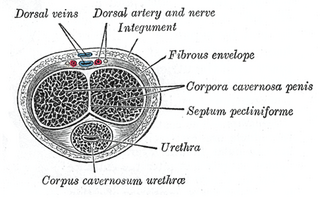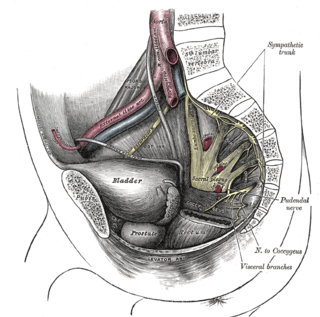Erectile dysfunction (ED), also called impotence, is the type of sexual dysfunction in which the penis fails to become or stay erect during sexual activity. It is the most common sexual problem in men. Through its connection to self-image and to problems in sexual relationships, erectile dysfunction can cause psychological harm.

Priapism is a condition in which a penis remains erect for hours in the absence of stimulation or after stimulation has ended. There are three types: ischemic (low-flow), nonischemic (high-flow), and recurrent ischemic (intermittent). Most cases are ischemic. Ischemic priapism is generally painful while nonischemic priapism is not. In ischemic priapism, most of the penis is hard; however, the glans penis is not. In nonischemic priapism, the entire penis is only somewhat hard. Very rarely, clitoral priapism occurs in women.

Peyronie's disease is a connective tissue disorder involving the growth of fibrous plaques in the soft tissue of the penis. Specifically, scar tissue forms in the tunica albuginea, the thick sheath of tissue surrounding the corpora cavernosa, causing pain, abnormal curvature, erectile dysfunction, indentation, loss of girth and shortening.

Penis enlargement, or male enhancement, is any technique aimed to increase the size of a human penis. Some methods aim to increase total length, others the shaft's girth, and yet others the glans size. Techniques include surgery, supplements, ointments, patches, and physical methods like pumping, jelqing, and traction.
Tumescence is the quality or state of being tumescent or swollen. Tumescence usually refers to the normal engorgement with blood of the erectile tissues, marking sexual excitation, and possible readiness for sexual activity. The tumescent sexual organ in males is the penis and in females is the clitoris and other parts of the genitalia like the vestibular bulbs. Arteries in the penis dilate to increase blood volume.

A corpus cavernosum penis (singular) is one of a pair of sponge-like regions of erectile tissue, which contain most of the blood in the penis during an erection.

Prostaglandin E1 (PGE1), also known as alprostadil, is a naturally occurring prostaglandin which is used as a medication. In infants with congenital heart defects, it is delivered by slow injection into a vein to open the ductus arteriosus until surgery can be carried out. By injection into the penis or placement in the urethra, it is used to treat erectile dysfunction.
Nocturnal penile tumescence is a spontaneous erection of the penis during sleep or when waking up. Along with nocturnal clitoral tumescence, it is also known as sleep-related erection. Men without physiological erectile dysfunction or severe depression experience nocturnal penile tumescence, usually three to five times during a period of sleep, typically during rapid eye movement sleep. Nocturnal penile tumescence is believed to contribute to penile health.
Venous leak, also called venogenic erectile dysfunction and penile venous insufficiency, is one category of vasculogenic impotence — a cause of erectile dysfunction in males. It affects all ages, being particularly awkward in young men. Much about venous leaks has not reached a consensus among the medical community, and many aspects of the condition, particularly its treatment strategies, are controversial. The prevalence of the condition is still unknown, although some sources claim it to be a common cause of erectile dysfunction.

The helicine arteries of penis are arteries in the penis. They are found in the corpora cavernosa penis.
The cavernous nerves are post-ganglionic parasympathetic nerves that facilitate penile erection and clitoral erection. They arise from cell bodies in the inferior hypogastric plexus where they receive the pre-ganglionic pelvic splanchnic nerves (S2-S4).

A penile implant is an implanted device intended for the treatment of erectile dysfunction, Peyronie's disease, ischemic priapism, deformity and any traumatic injury of the penis, and for phalloplasty or metoidioplasty, including in gender-affirming surgery. Men also opt for penile implants for aesthetic purposes. Men's satisfaction and sexual function is influenced by discomfort over genital size which leads to seek surgical and non-surgical solutions for penis alteration. Although there are many distinct types of implants, most fall into one of two categories: malleable and inflatable transplants.

An erection is a physiological phenomenon in which the penis becomes firm, engorged, and enlarged. Penile erection is the result of a complex interaction of psychological, neural, vascular, and endocrine factors, and is often associated with sexual arousal, sexual attraction or libido, although erections can also be spontaneous. The shape, angle, and direction of an erection vary considerably between humans.

Clitoral erection is a physiological phenomenon where the clitoris becomes enlarged and firm.
Bulbar urethral necrosis is a problem that can occur after a pelvic fracture associated urethral distraction defect (PFUDD).

Ronald Virag is a French cardiovascular surgeon who specialises in andrology, the study of the male reproductive system. After training in general and cardiovascular surgery at Paris University, he shifted his focus to the study of erectile dysfunction, which has been his primary area of study since 1978. In 1981, he founded a private institute in France dedicated to the clinical study of erectile dysfunction and developed early programs using intracavernosal drugs to treat the condition.

Penile Artery Shunt Syndrome (PASS) is an iatrogenic clinical phenomenon first described by Tariq Hakky, Christopher Yang, Jonathan Pavlinec, Kamal Massis, and Rafael Carrion within the Sexual Medicine Program in the Department of Urology, at the University of South Florida, and Ricardo Munarriz, of Boston University School of Medicine Department of Urology in 2013. It may be a cause of refractory Erectile Dysfunction in patients who have undergone Penile Revascularization Surgery.
A penile injury is a medical emergency that afflicts the penis. Common injuries include fracture, avulsion injury, strangulation, entrapment, and amputation.
Penile ulltrasonography is medical ultrasonography of the penis. Ultrasound is an excellent method for the study of the penis, such as indicated in trauma, priapism, erectile dysfunction or suspected Peyronie's disease.

Hard flaccid syndrome (HFS), also known as hard flaccid (HF), is a chronic painful condition characterized by a semi-rigid penis at the flaccid state, a soft glans at the erect state, pelvic pain, low libido, erectile dysfunction, erectile pain, pain on ejaculation, penile sensory changes (numbness or coldness), lower urinary tract symptoms, contraction of the pelvic floor muscles, and psychological distress. Other complaints include rectal and perineal discomfort, cold hands and feet, and a hollow or detached feeling inside the penile shaft. The majority of HFS patients are in their 20s–30s and symptoms significantly affect one's quality of life.












